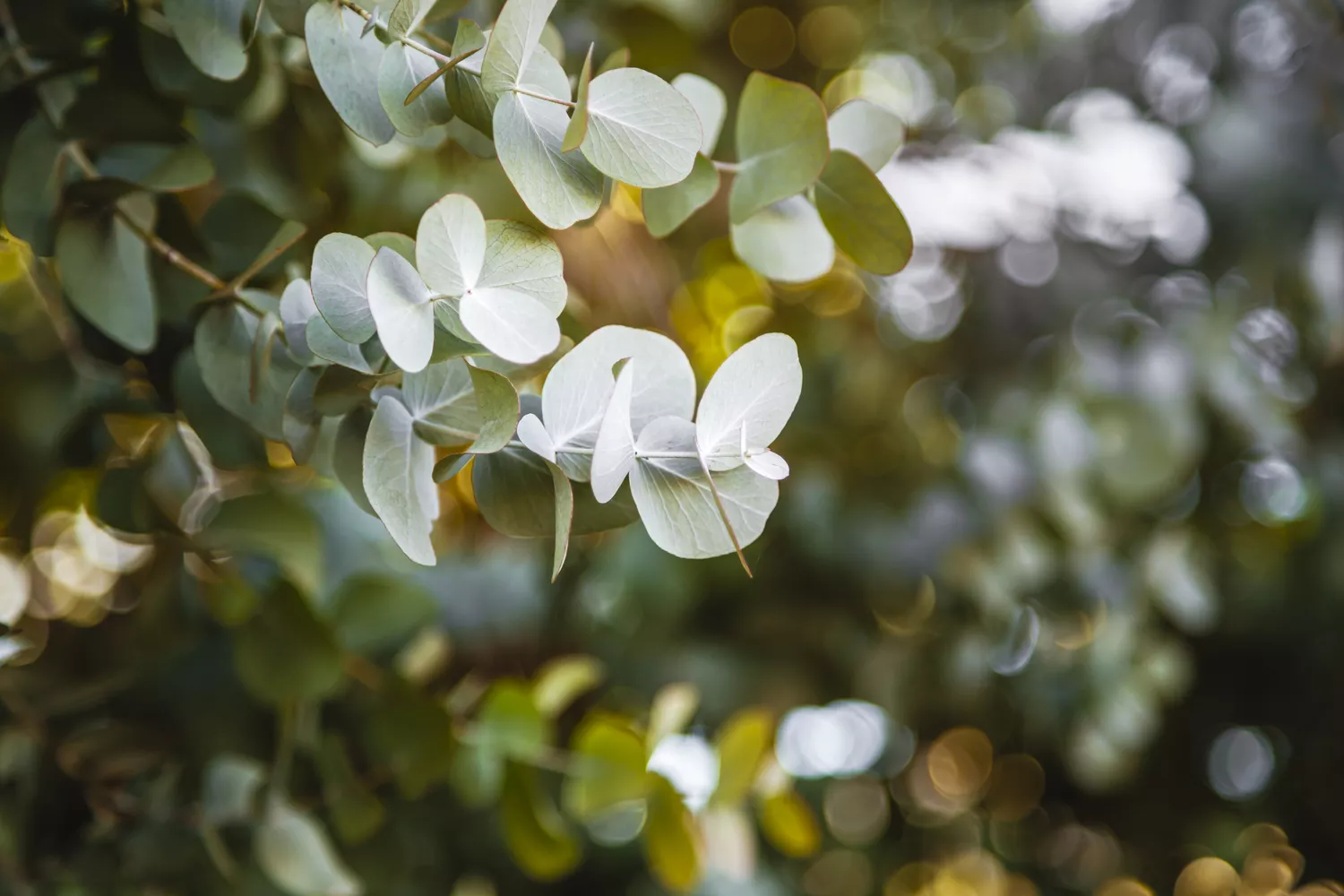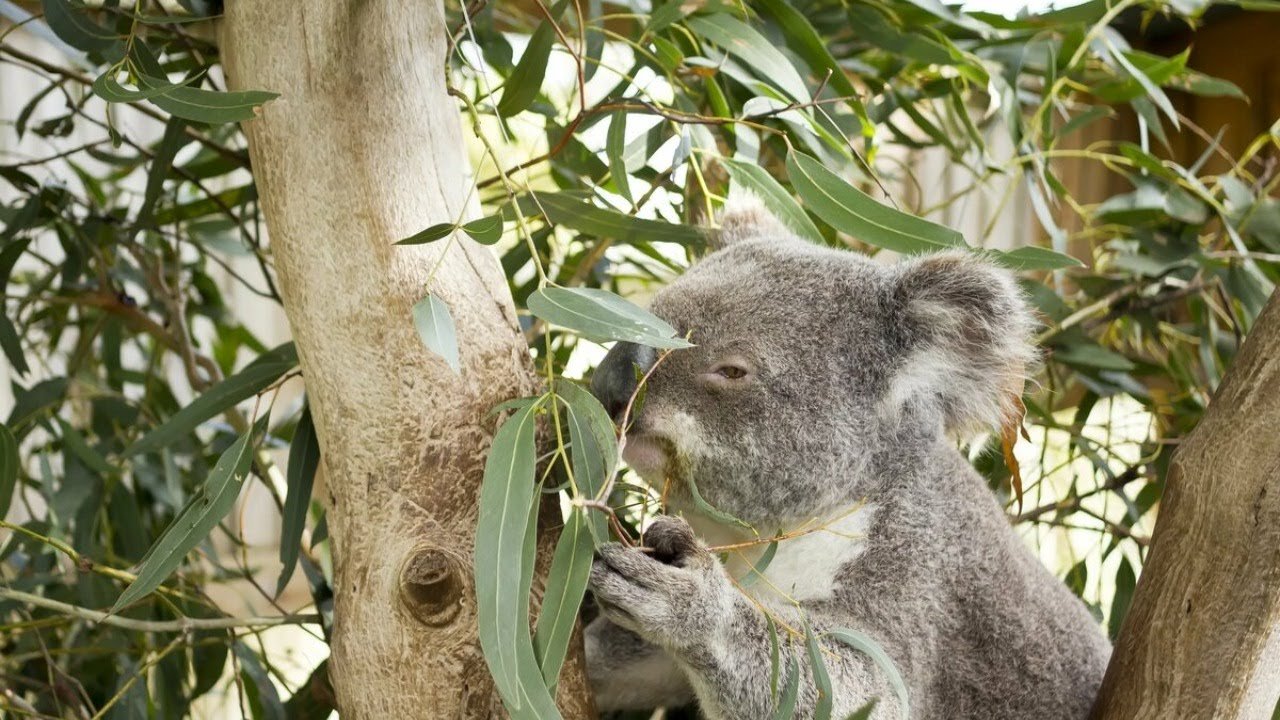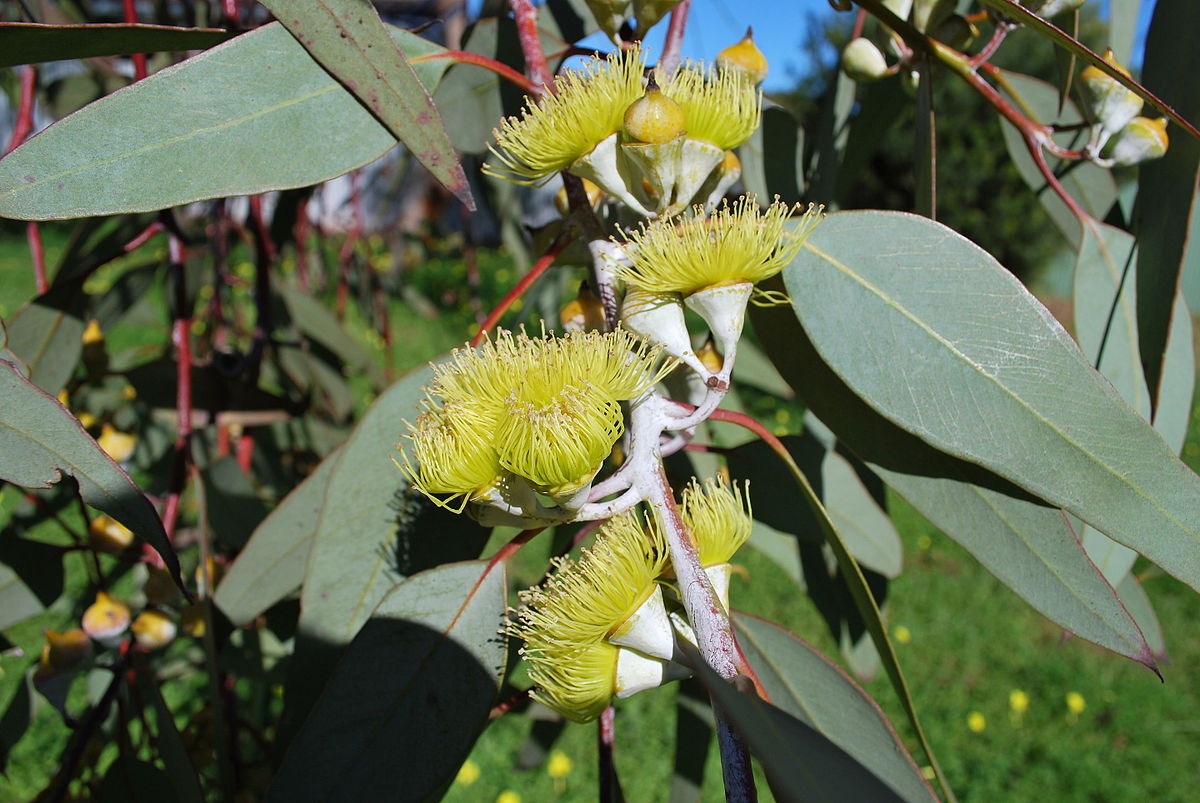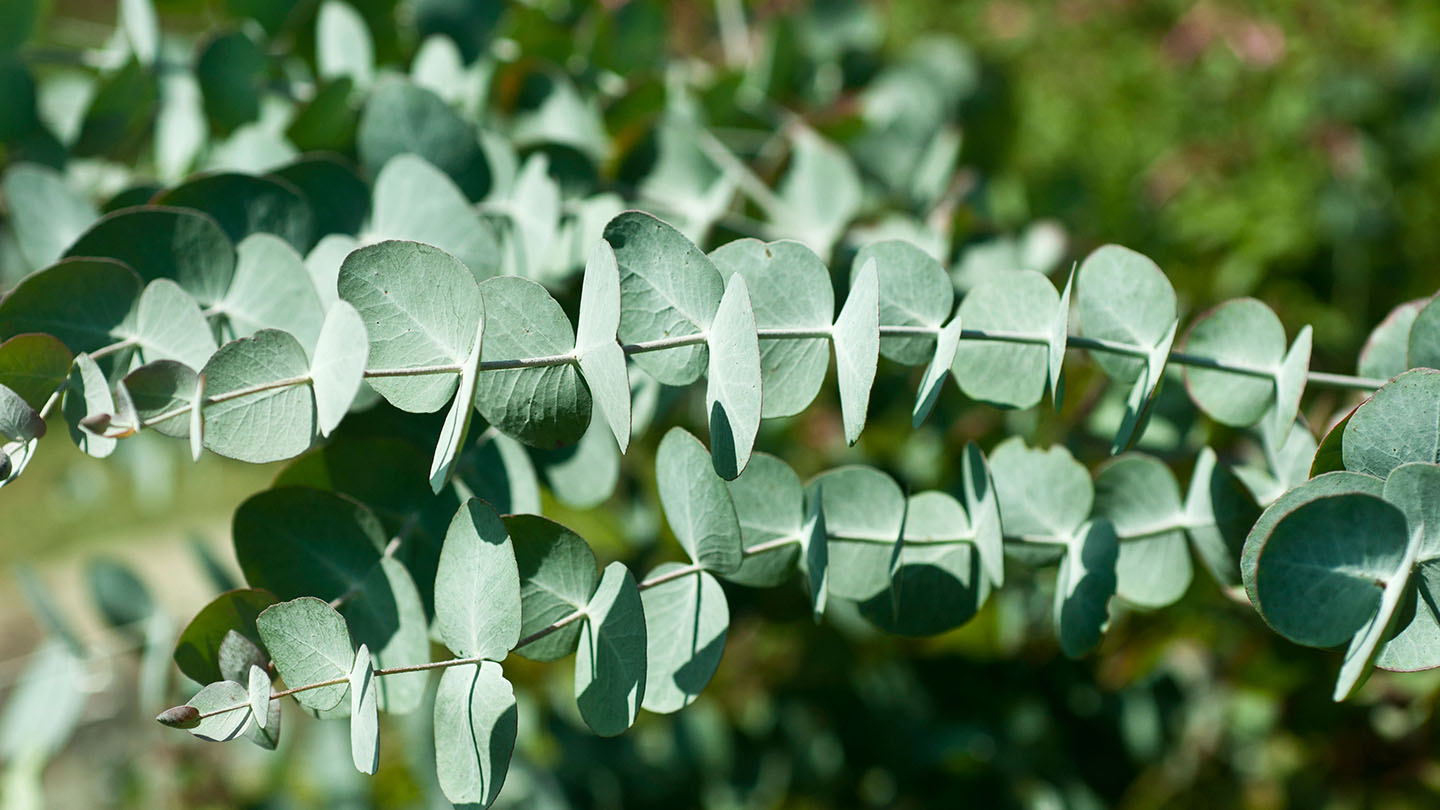The rounded blue-green foliage of eucalyptus is a favorite among florists and adds gorgeous texture to gardens.
Eucalyptus is a versatile plant in the home and garden. Houseplant enthusiasts adore the fragrance it brings to the home. Eucalyptus makes a striking accent in landscapes with gorgeous foliage and colorful bark. Eucalyptus plants are easy to care for and can be grown in containers, maintained as a shrub, or allowed to mature into a tree. They are often trained as a standard.
The aromatic foliage of eucalyptus takes on two distinct shapes: juvenile and adult. The silver coin-shaped juvenile foliage gives eucalyptus its common name, silver dollar tree. This striking blue foliage is widely used in fresh and dried flower arrangements. Adult foliage is elongated, waxy, and a muted green color. In spring, small white flowers appear on mature trees. Plants can be pruned to maintain juvenile foliage and a more compact habit.
Plant Attributes
| Common Name | Eucalyptus |
| Botanical Name | Eucalyptus cinerea |
| Family | Myrtaceae |
| Plant Type | Perennial, Tree or Shrub, Evergreen |
| Mature Size | 15-50 ft. tall, 10-15 ft. wide |
| Sun Exposure | Full Sun |
| Soil Type | Clay, Loam, Sand, Well-Drained |
| Soil pH | Slightly Acidic (5.5-6.5) |
| Bloom Time | Spring (mature plants only) |
| Flower Color | White |
| Hardiness Zones | 8-11 (USDA) |
| Native Area | Australia |
| Toxicity | Toxic to Humans, Dogs, Cats and Horses |
Eucalyptus Care
Eucalyptus is a fast-growing plant that can grow six to eight feet in a season. In locations where it is winter hardy, eucalyptus is commonly grown as a landscape tree or pruned to maintain a bushy habit for use as a windbreak or in mixed borders. In colder regions, eucalyptus must be overwintered indoors or grown as an annual shrub from seedlings planted in spring. Plants are drought tolerant once established and resist deer browsing. Salt and wind tolerance makes eucalyptus useful in coastal landscapes.
Light
Eucalyptus grows in full sun, requiring at least six hours of direct sun per day.
Soil
Plants are drought tolerant once established. They perform well in dry to medium soils with good drainage.
Water
Eucalyptus has low to moderate water needs. Young plants require more water to support growth and establish roots. Water deeply to encourage deep rooting.
Temperature and Humidity
Originating in arid climates, eucalyptus has low requirements for humidity, making them easy to maintain indoors. In the garden, plants are not always reliably hardy in winter but will quickly regrow from the roots after a hard freeze.
Fertilizer
Eucalyptus plants growing in the ground outdoors will not likely require supplemental fertilizer, except in poor soils. Potted plants, indoors and out, benefit from a slow-release fertilizer during the growing season.

Caring For Eucalyptus Indoors
Eucalyptus makes a wonderful houseplant but be aware that plants are toxic to people, dogs, cats, and horses.12 Start with high-quality potting soil containing perlite to promote drainage. Eucalyptus plants need plenty of light and perform best in a south-facing window. Provide regular watering during the growing season and reduce irrigation frequency during the winter. Because eucalyptus grows quickly, plants may require repotting each spring. Size can be maintained by pruning foliage back hard after the growing season.
Types Of Eucalyptus
Silver dollar tree is just one of over 700 species in the genus Eucalyptus, all native to Australia and some surrounding islands.3 In their native range, eucalyptus trees are called gum trees, which is reflected in many of the species names listed below. Due to its popularity in the florist trade, several species of Eucalyptus are available from seed companies and specialty growers. Others are sold as landscape trees or shrubs.
Eucalyptus Species Grown for Cutting
The silver-leaved mountain gum, Eucalyptus pulverulenta, is among the most popular eucalyptus grown for cutting. The variety ‘Baby Blue’ produces exceptionally striking blue foliage. Willow peppermint, E. nicholii, is notable for its slender gray-green foliage that adds delicate texture to arrangements. Lemon eucalyptus, E. citriodora, has a unique citrus fragrance and long, arrow-shaped leaves that take on red hues in the fall. The feature of this article, silver dollar tree or E. cinerea, is also commonly grown for cutting.
Eucalyptus Species To Grow as Houseplants
Many of the eucalyptus species grown for cuttings also make great houseplants, including lemon eucalyptus and silver dollar tree. Another popular species for indoor gardening, cider gum or E. gunnii includes several compact varieties such as ‘Silver Drop’ which features small, metallic foliage. E. albida, is slow-growing and easy to maintain in containers.
Eucalyptus Species To Avoid
Some eucalyptus species are considered invasive and should be avoided in the landscape. In Florida, rainbow eucalyptus, E. deglupta, is a species of concern.4 Many Florida counties restrict planting of this and other eucalyptus species. In California, several species including the blue gum tree, E. globulus, are considered highly invasive.5 Check local guidelines before planting eucalyptus and avoid species known to be problematic.

How To Grow Eucalyptus from Seed
Eucalyptus grows very quickly from seed, making this an economical way to start new plants. Sow seeds indoors 10 to 12 weeks before the average last frost date for your area.
- Fill a seed tray or other shallow container with a seed-starting soil mix. Deeper cell packs work well for eucalyptus as they don’t like their roots disturbed. Make sure the container has drainage holes in the bottom.
- Before sowing seeds, moisten the soil evenly until it is damp but not soaked.
- Sow seeds on the soil surface and gently press into the soil before covering with a very thin layer of soil or fine sand.
- Maintain a temperature between 65˚F to 75˚F during the day and night. Water trays from the bottom or use a mister to keep the soil moist without disturbing the seeds. Covering the seed tray loosely with plastic is an excellent way to maintain soil moisture.
- Eucalyptus seeds are slow to germinate and benefit from a heating pad. Seedlings will emerge in 14 to 21 days or longer, depending on the species. Remove plastic when seedlings emerge and move seedlings off of the heat pad.
- Provide seedlings with bright light for 14 to 16 hours per day. If supplemental lighting is needed, use a fluorescent plant light set three to four inches above the seedlings, raising it as plants grow.
- If seeds were started in trays, transplant individually into three to four-inch pots when the first true leaves emerge. For plants intended to be grown indoors, wait to transplant into individual pots when plants reach four to five inches.
- Begin hardening off seedlings about one week before transplanting into the garden or outdoor containers.
Pruning Eucalyptus
Unless you plan to grow eucalyptus as a tree, plants will require regular pruning to maintain their size. And gardeners looking to grow eucalyptus for cuttings will need to follow a regular pruning schedule. Different pruning methods can be used, depending on your goals.
Coppice pruning is the secret to keeping eucalyptus plants producing that stunning juvenile foliage. This pruning mthod involves cutting the entire plant back to the ground in late winter or early spring. Most species of eucalyptus respond well to coppice pruning. Plants produce new shoots from the base, creating a multi-stemmed bush of juvenile foliage. Repeat coppicing yearly to rejuvenate plants.
Eucalyptus plants can also be maintained as a hedge or large shrub. Begin pruning after the second growing season, removing about one-third the height of each stem. In subsequent years, prune stems back by one-quarter. If plants are not well branched, you can coppice prune as above to encourage branching, then begin pruning for height after two growing seasons.

Overwintering Eucalyptus
If you live outside the hardiness zone for eucalyptus, you will need to bring plants indoors before the first frost to store them over winter. A simple way to maintain eucalyptus over the winter is to stool them and store them in a cool, dark basement or frost-free garage. Stooling is a pruning method that removes the foliage, leaving only the stems and roots to overwinter in a dormant state. To stool bushy plants, cut stems back to the ground as you would when coppicing. Plants grown as a standard can be stooled by cutting the branches back to the trunk.
Eucalyptus can also be overwintered as a houseplant. When bringing eucalyptus indoors in the fall, isolate plants for a few weeks to make sure they are pest free before introducing them to other houseplants. Place eucalyptus in a bright window and reduce watering over the winter months.

Common Problems
Eucalyptus is not bothered by any serious insect or disease pests. In humid conditions, powdery mildew can develop on foliage. Maintain good air circulation around plants to minimize the occurrence. Eucalyptus is accustomed to arid conditions and can be sensitive to overwatering. Inadequate drainage or excessive watering can lead to root rot. Site plants accordingly and manage irrigation to prevent waterlogged roots.





